+ データを開く
データを開く
- 基本情報
基本情報
| 登録情報 | データベース: PDB / ID: 6ot0 | ||||||
|---|---|---|---|---|---|---|---|
| タイトル | Structure of human Smoothened-Gi complex | ||||||
 要素 要素 |
| ||||||
 キーワード キーワード | SIGNALING PROTEIN / GPCR / Complex / Hedgehog signaling | ||||||
| 機能・相同性 |  機能・相同性情報 機能・相同性情報ventral midline determination / mesenchymal to epithelial transition involved in metanephric renal vesicle formation / response to inositol / regulation of heart morphogenesis / contact inhibition / negative regulation of hair follicle development / 9+0 non-motile cilium / pancreas morphogenesis / regulation of somatic stem cell population maintenance / epithelial-mesenchymal cell signaling ...ventral midline determination / mesenchymal to epithelial transition involved in metanephric renal vesicle formation / response to inositol / regulation of heart morphogenesis / contact inhibition / negative regulation of hair follicle development / 9+0 non-motile cilium / pancreas morphogenesis / regulation of somatic stem cell population maintenance / epithelial-mesenchymal cell signaling / myoblast migration / atrial septum morphogenesis / spinal cord dorsal/ventral patterning / determination of left/right asymmetry in lateral mesoderm / left/right axis specification / Activation of SMO / ciliary tip / patched binding / forebrain morphogenesis / type B pancreatic cell development / somite development / positive regulation of organ growth / dorsal/ventral neural tube patterning / BBSome-mediated cargo-targeting to cilium / smooth muscle tissue development / cerebellar cortex morphogenesis / positive regulation of branching involved in ureteric bud morphogenesis / cellular response to cholesterol / pattern specification process / mammary gland epithelial cell differentiation / dentate gyrus development / commissural neuron axon guidance / thalamus development / dopaminergic neuron differentiation / central nervous system neuron differentiation / oxysterol binding / positive regulation of multicellular organism growth / positive regulation of smoothened signaling pathway / Class B/2 (Secretin family receptors) / cell fate specification / cAMP-dependent protein kinase inhibitor activity / neural crest cell migration / negative regulation of DNA binding / anterior/posterior pattern specification / positive regulation of mesenchymal cell proliferation / ciliary membrane / hair follicle morphogenesis / midgut development / smoothened signaling pathway / negative regulation of epithelial cell differentiation / positive regulation of neuroblast proliferation / heart looping / protein kinase A catalytic subunit binding / endoplasmic reticulum-Golgi intermediate compartment / odontogenesis of dentin-containing tooth / negative regulation of protein phosphorylation / neuroblast proliferation / adenylate cyclase inhibitor activity / vasculogenesis / Hedgehog 'off' state / positive regulation of protein localization to cell cortex / T cell migration / Adenylate cyclase inhibitory pathway / skeletal muscle fiber development / D2 dopamine receptor binding / response to prostaglandin E / G protein-coupled serotonin receptor binding / adenylate cyclase regulator activity / adenylate cyclase-inhibiting serotonin receptor signaling pathway / centriole / cellular response to forskolin / homeostasis of number of cells within a tissue / regulation of mitotic spindle organization / protein sequestering activity / positive regulation of epithelial cell proliferation / central nervous system development / epithelial cell proliferation / astrocyte activation / Regulation of insulin secretion / positive regulation of cholesterol biosynthetic process / G protein-coupled receptor binding / negative regulation of insulin secretion / G protein-coupled receptor activity / Hedgehog 'on' state / adenylate cyclase-inhibiting G protein-coupled receptor signaling pathway / cerebral cortex development / response to peptide hormone / adenylate cyclase-modulating G protein-coupled receptor signaling pathway / G-protein beta/gamma-subunit complex binding / centriolar satellite / positive regulation of protein import into nucleus / Olfactory Signaling Pathway / multicellular organism growth / Activation of the phototransduction cascade / G beta:gamma signalling through PLC beta / Presynaptic function of Kainate receptors / Thromboxane signalling through TP receptor / G protein-coupled acetylcholine receptor signaling pathway / G-protein activation / Activation of G protein gated Potassium channels 類似検索 - 分子機能 | ||||||
| 生物種 |  Homo sapiens (ヒト) Homo sapiens (ヒト) | ||||||
| 手法 | 電子顕微鏡法 / 単粒子再構成法 / 解像度: 3.84 Å | ||||||
 データ登録者 データ登録者 | Qi, X. / Li, X. | ||||||
 引用 引用 |  ジャーナル: Nature / 年: 2019 ジャーナル: Nature / 年: 2019タイトル: Cryo-EM structure of oxysterol-bound human Smoothened coupled to a heterotrimeric G. 著者: Xiaofeng Qi / Heng Liu / Bonne Thompson / Jeffrey McDonald / Cheng Zhang / Xiaochun Li /  要旨: The oncoprotein Smoothened (SMO), a G-protein-coupled receptor (GPCR) of the Frizzled-class (class-F), transduces the Hedgehog signal from the tumour suppressor Patched-1 (PTCH1) to the glioma- ...The oncoprotein Smoothened (SMO), a G-protein-coupled receptor (GPCR) of the Frizzled-class (class-F), transduces the Hedgehog signal from the tumour suppressor Patched-1 (PTCH1) to the glioma-associated-oncogene (GLI) transcription factors, which activates the Hedgehog signalling pathway. It has remained unknown how PTCH1 modulates SMO, how SMO is stimulated to form a complex with heterotrimeric G proteins and whether G-protein coupling contributes to the activation of GLI proteins. Here we show that 24,25-epoxycholesterol, which we identify as an endogenous ligand of PTCH1, can stimulate Hedgehog signalling in cells and can trigger G-protein signalling via human SMO in vitro. We present a cryo-electron microscopy structure of human SMO bound to 24(S),25-epoxycholesterol and coupled to a heterotrimeric G protein. The structure reveals a ligand-binding site for 24(S),25-epoxycholesterol in the 7-transmembrane region, as well as a G-coupled activation mechanism of human SMO. Notably, the G protein presents a different arrangement from that of class-A GPCR-G complexes. Our work provides molecular insights into Hedgehog signal transduction and the activation of a class-F GPCR. | ||||||
| 履歴 |
|
- 構造の表示
構造の表示
| ムービー |
 ムービービューア ムービービューア |
|---|---|
| 構造ビューア | 分子:  Molmil Molmil Jmol/JSmol Jmol/JSmol |
- ダウンロードとリンク
ダウンロードとリンク
- ダウンロード
ダウンロード
| PDBx/mmCIF形式 |  6ot0.cif.gz 6ot0.cif.gz | 286 KB | 表示 |  PDBx/mmCIF形式 PDBx/mmCIF形式 |
|---|---|---|---|---|
| PDB形式 |  pdb6ot0.ent.gz pdb6ot0.ent.gz | 220.7 KB | 表示 |  PDB形式 PDB形式 |
| PDBx/mmJSON形式 |  6ot0.json.gz 6ot0.json.gz | ツリー表示 |  PDBx/mmJSON形式 PDBx/mmJSON形式 | |
| その他 |  その他のダウンロード その他のダウンロード |
-検証レポート
| 文書・要旨 |  6ot0_validation.pdf.gz 6ot0_validation.pdf.gz | 1 MB | 表示 |  wwPDB検証レポート wwPDB検証レポート |
|---|---|---|---|---|
| 文書・詳細版 |  6ot0_full_validation.pdf.gz 6ot0_full_validation.pdf.gz | 1 MB | 表示 | |
| XML形式データ |  6ot0_validation.xml.gz 6ot0_validation.xml.gz | 40.6 KB | 表示 | |
| CIF形式データ |  6ot0_validation.cif.gz 6ot0_validation.cif.gz | 62 KB | 表示 | |
| アーカイブディレクトリ |  https://data.pdbj.org/pub/pdb/validation_reports/ot/6ot0 https://data.pdbj.org/pub/pdb/validation_reports/ot/6ot0 ftp://data.pdbj.org/pub/pdb/validation_reports/ot/6ot0 ftp://data.pdbj.org/pub/pdb/validation_reports/ot/6ot0 | HTTPS FTP |
-関連構造データ
- リンク
リンク
- 集合体
集合体
| 登録構造単位 | 
|
|---|---|
| 1 |
|
- 要素
要素
-Guanine nucleotide-binding protein ... , 3種, 3分子 ABG
| #2: タンパク質 | 分子量: 40414.047 Da / 分子数: 1 / 由来タイプ: 組換発現 / 由来: (組換発現)  Homo sapiens (ヒト) / 遺伝子: GNAI1 Homo sapiens (ヒト) / 遺伝子: GNAI1発現宿主:  参照: UniProt: P63096 |
|---|---|
| #3: タンパク質 | 分子量: 38744.371 Da / 分子数: 1 / 由来タイプ: 組換発現 / 由来: (組換発現)  Homo sapiens (ヒト) / 遺伝子: GNB1 Homo sapiens (ヒト) / 遺伝子: GNB1発現宿主:  参照: UniProt: P62873 |
| #4: タンパク質 | 分子量: 7861.143 Da / 分子数: 1 / 由来タイプ: 組換発現 / 由来: (組換発現)  Homo sapiens (ヒト) / 遺伝子: GNG2 Homo sapiens (ヒト) / 遺伝子: GNG2発現宿主:  参照: UniProt: P59768 |
-抗体 , 2種, 2分子 LH
| #5: 抗体 | 分子量: 23258.783 Da / 分子数: 1 / 由来タイプ: 組換発現 / 由来: (組換発現)   |
|---|---|
| #6: 抗体 | 分子量: 25788.822 Da / 分子数: 1 / 由来タイプ: 組換発現 / 由来: (組換発現)   |
-タンパク質 / 非ポリマー , 2種, 2分子 R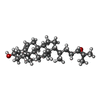

| #1: タンパク質 | 分子量: 62109.387 Da / 分子数: 1 / 断片: residues 1-555 / 由来タイプ: 組換発現 / 由来: (組換発現)  Homo sapiens (ヒト) / 遺伝子: SMO, SMOH / 発現宿主: Homo sapiens (ヒト) / 遺伝子: SMO, SMOH / 発現宿主:  Homo sapiens (ヒト) / 参照: UniProt: Q99835 Homo sapiens (ヒト) / 参照: UniProt: Q99835 |
|---|---|
| #7: 化合物 | ChemComp-CO1 / |
-詳細
| Has protein modification | Y |
|---|
-実験情報
-実験
| 実験 | 手法: 電子顕微鏡法 |
|---|---|
| EM実験 | 試料の集合状態: PARTICLE / 3次元再構成法: 単粒子再構成法 |
- 試料調製
試料調製
| 構成要素 |
| ||||||||||||||||||||||||||||||
|---|---|---|---|---|---|---|---|---|---|---|---|---|---|---|---|---|---|---|---|---|---|---|---|---|---|---|---|---|---|---|---|
| 分子量 | 値: 0.250 MDa / 実験値: YES | ||||||||||||||||||||||||||||||
| 由来(天然) |
| ||||||||||||||||||||||||||||||
| 由来(組換発現) |
| ||||||||||||||||||||||||||||||
| 緩衝液 | pH: 7.5 | ||||||||||||||||||||||||||||||
| 試料 | 包埋: NO / シャドウイング: NO / 染色: NO / 凍結: NO |
- 電子顕微鏡撮影
電子顕微鏡撮影
| 実験機器 |  モデル: Titan Krios / 画像提供: FEI Company |
|---|---|
| 顕微鏡 | モデル: FEI TITAN KRIOS |
| 電子銃 | 電子線源:  FIELD EMISSION GUN / 加速電圧: 300 kV / 照射モード: FLOOD BEAM FIELD EMISSION GUN / 加速電圧: 300 kV / 照射モード: FLOOD BEAM |
| 電子レンズ | モード: DARK FIELD |
| 撮影 | 電子線照射量: 1.4 e/Å2 フィルム・検出器のモデル: GATAN K2 SUMMIT (4k x 4k) |
- 解析
解析
| ソフトウェア | 名称: REFMAC / バージョン: 5.8.0158 / 分類: 精密化 | ||||||||||||||||||||||||||||||||||||||||||||||||||||||||||||||||||||||||||||||||||||||||||||||||||||||||||
|---|---|---|---|---|---|---|---|---|---|---|---|---|---|---|---|---|---|---|---|---|---|---|---|---|---|---|---|---|---|---|---|---|---|---|---|---|---|---|---|---|---|---|---|---|---|---|---|---|---|---|---|---|---|---|---|---|---|---|---|---|---|---|---|---|---|---|---|---|---|---|---|---|---|---|---|---|---|---|---|---|---|---|---|---|---|---|---|---|---|---|---|---|---|---|---|---|---|---|---|---|---|---|---|---|---|---|---|
| CTF補正 | タイプ: NONE | ||||||||||||||||||||||||||||||||||||||||||||||||||||||||||||||||||||||||||||||||||||||||||||||||||||||||||
| 3次元再構成 | 解像度: 3.84 Å / 解像度の算出法: FSC 0.143 CUT-OFF / 粒子像の数: 141100 / 対称性のタイプ: POINT | ||||||||||||||||||||||||||||||||||||||||||||||||||||||||||||||||||||||||||||||||||||||||||||||||||||||||||
| 精密化 | 解像度: 3.84→3.84 Å / Cor.coef. Fo:Fc: 0.876 / SU B: 148.702 / SU ML: 1.573 / ESU R: 0.975 立体化学のターゲット値: MAXIMUM LIKELIHOOD WITH PHASES 詳細: HYDROGENS HAVE BEEN ADDED IN THE RIDING POSITIONS
| ||||||||||||||||||||||||||||||||||||||||||||||||||||||||||||||||||||||||||||||||||||||||||||||||||||||||||
| 溶媒の処理 | イオンプローブ半径: 0.8 Å / 減衰半径: 0.8 Å / VDWプローブ半径: 1.2 Å / 溶媒モデル: MASK | ||||||||||||||||||||||||||||||||||||||||||||||||||||||||||||||||||||||||||||||||||||||||||||||||||||||||||
| 原子変位パラメータ | Biso mean: 200.285 Å2
| ||||||||||||||||||||||||||||||||||||||||||||||||||||||||||||||||||||||||||||||||||||||||||||||||||||||||||
| 精密化ステップ | サイクル: 1 / 合計: 10572 | ||||||||||||||||||||||||||||||||||||||||||||||||||||||||||||||||||||||||||||||||||||||||||||||||||||||||||
| 拘束条件 |
|
 ムービー
ムービー コントローラー
コントローラー




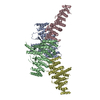




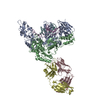
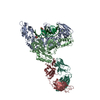
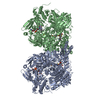
 PDBj
PDBj


























